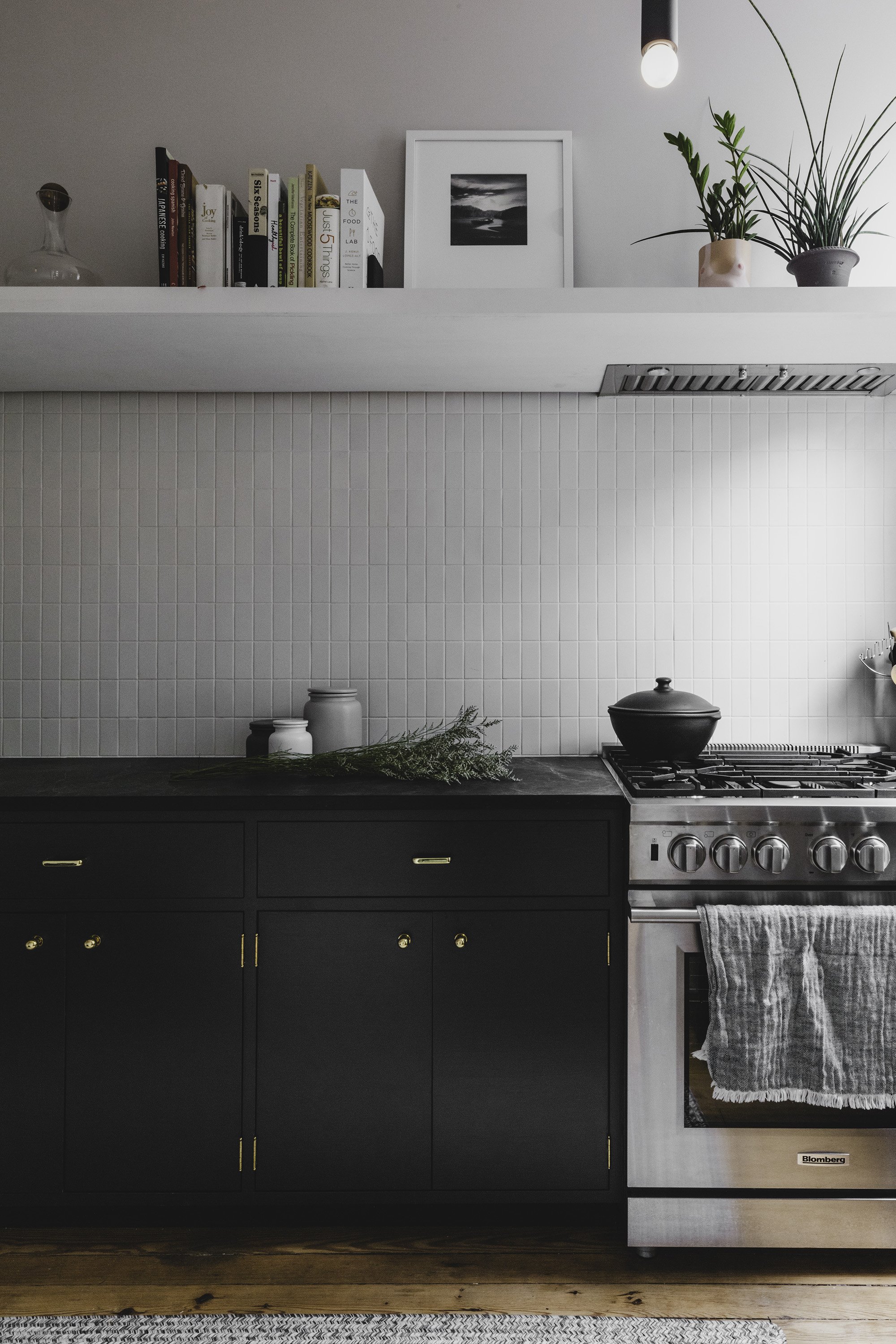Range Hoods in a Minimalist Kitchen
types, design tips, and resources for
maximum ventilation with minimum visual impact
Design Considerations
Typically, we try to make the hood as visually quiet as we can. Ventilation is great, but it doesn’t need to be the crown jewel of the kitchen! This is always a big consideration, especially when we are designing in Brownstone and townhouse projects, with an open kitchen on the parlor floor. We usually select ventilation hood inserts, and have a custom enclosure built around it, to minimize the amount of stainless steel that we see.
One option is to create a simple rectangular hood, and paint it to match the wall. This can be especially nice if the cabinetry beneath it is a contrasting color or tone, because that can pull your eye away from the hood.
Alternatively, if you want to disguise the mass of the hood, you can build it into upper cabinetry. It’s important to consider the depth of your hood in this case, as you will likely want to select a narrower hood.
In some cases, the hood can be hidden within architectural elements, which can disguise it completely. In the following kitchen, the wall surface above the white shelf is bumped out the length of the kitchen, to conceal the hood behind it completely.
Main Types of Range Hoods, and How to Choose
There are three main types:
Ducted, which has a ducted route that exhausts to the outdoors. This is the best option, if it’s possible, especially for home cooks that prepare meat or smoky dishes, like blackened fish.
Recirculating, which has a series of filters inside them that trap particles and oils before returning the filtered air back into the room. These filters are often removable, and need to be replaced or cleaned occasionally. Often these filters can go through the dishwasher, which makes this quite easy.
Convertible, which is basically a ducted unit that can be converted to a recirculating hood by adding some extra filtration. Sometimes there is a separate “recirculating kit” that needs to be ordered with the hood.
When we are choosing, the first thing we consider is whether it’s possible to install a ducted unit. In freestanding homes this is often fairly easy, but in apartments, especially older buildings, we often don’t have this option. Often we end up using a “convertible’ insert unit, which we create a custom shroud for. Sometimes we install a very short duct above the convertible unit, so we can locate the return air grille in a less visible location.
Ventilation Requirements for Range Hoods
We always consider several factors each time we specify these for a project. For sizing, it’s good to select a unit that is the same width as your cooktop, and as deep as possible, without compromising the design. Blower speed is important, and it depends on the size of your range, its BTU capacity, and how heavily used the cooking space will be used. A good rule of thumb is:
36” range: 350-700 CFM
48” range: 400 - 800 CFM
For moderately used residential spaces the lower end is often enough. Another thing to consider is that by code, any ducted hood over 400CFM actually requires fresh air to be drawn back into the space, to make up for the air that was extracted. Because of this, we often try to stick with 400CFM units.
Sound is important, and the ratings are helpful, but generally speaking, the stronger the fan, the louder the unit will be, unless you use a remote blower.
And built-in lights are an absolute must!
Product Recommendations
VIKING 5 SERIES CUSTOM VENTILATOR SYSTEM
One of the best options, if you can use a ducted unit, is the Viking Custom Ventilator. This unit can use a remote fan, which is located at the end of the duct run, outdoors, which means it barely makes any noise inside while it’s being used.
Bertazzoni Professional Series Insert
This Bertazzoni ventilator is also quite nice. It is a bit deeper than a typical upper cabinet, which is something to consider during design. Deeper models are typically better for extracting odors, since they can capture more of the cooktop surface.
Prestige Compact Ventilator Insert
The Prestige Compact Insert is one of the slimmest units that we know of that has an internal fan. At 11 ½” deep, this unit can be installed at the same depth as normal upper cabinetry. It comes with dishwasher-safe filters, dimmable lights and a powerful variable speed blower.

















